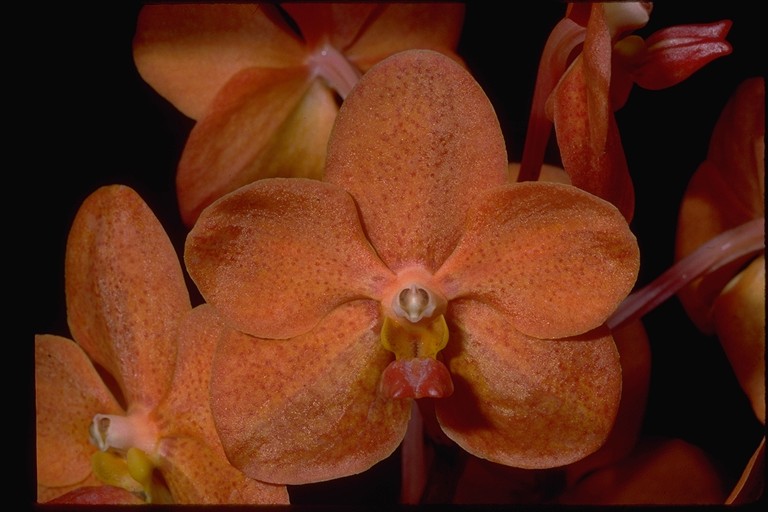

Ascda. Karnda "Mary Motes" HCC/AOS
February in your Orchid CollectionFebruary Climate DataAverage high: 77.7 Average low: 60.7 Average mean: 69.1 Average rainfall: 2.07" Despite the bloom on the avocados and the burgeoning new leaves on the live oaks, February is not spring in South Florida. Danger of freeze continues past mid month and frost can occur still into March. Even if the weather is balmy it's too early to let down our guard or take down any protection we have mounted against the cold. The trend however is toward the positive as each lengthening day brings extra hours of warming sunshine to begin waking our plants from their long winter's rest. February characteristically brings a wide swing of day to night temperatures, ideal for spiking ascocendas and vandas but also wringing from the air heavy dews and dense fog. Whilst these add a romantic atmosphere to the South Florida landscape, Wuthering Heights is singularly devoid of snails and slugs (much less Botrytis). The silvery carpet of dew provides a silky path to our orchids for snails and slugs which can range far, under these favorable conditions. They are eager to make a nice meal of your Phalaenopsis leaves or the soft crowns of your vandas before they retire during the dry months of March and April only to dream of the fresh shoots of the sympodial orchids brought forth by the first rains of May. Now is the time to give them a rude awakening. Remember that snail bait is most effectively applied lightly(scatter the pellets every few feet) and frequently (every 7 to 10 days). Two or three applications should do the job. The heavy fog which can cause condensation on leaves even under cover can also bring trouble. Botrytis is a fungus disease that can disfigure flowers with small black spots. Particularly apparent and annoying on white Phalaenopsis, Botrytis can ruin other flowers as well. Control is typically achieved in commercial greenhouses with fungicide in aerosol forms and by running fans to prevent condensation on the flowers. The latter option is also available to collectors. A small fan turned on the spiking and opened flowers at night will greatly alleviate the pressure of Botrytis. So will, to a degree, the application of soap which we suggested in January to control mites. Bicarbonate of soda, ordinary baking soda, at 1Tbs. per gal will help as well. Quaternary ammonium compounds (Physan, RD40, Consan, pool algicide) also give some control. Maintaining long lasting flowers like Phalaenopsis, dendrobiums and bi-foliate cattleyas in more perfect condition is well worth the effort. Having waited so long for the flowers we want to enjoy them as long as possible and they do all last longer in cool weather. The lower overall temperatures of February call for less frequent and lighter applications of fertilizer as was the practice in January. If any reddening of the foliage persists another application of Epsom salts (1Tbs per gal), preferably in combination with Potassium nitrate, is called for; Nitrate nitrogen being more available to the plants under cooler conditions. If your resolve holds steady not to water (or above all) fertilize those Himalayan dendrobiums, your reward may shortly become evident in bursting flower spikes. Like the avocados and the live oaks, many cattleyas and other sympodial orchids have bloomed and are just commencing new growth in February. Right after flowering is usually an excellent time for repotting from the plant's perspective and the cool day time temperatures in the greenhouse are hospitable to the orchid grower as well. It's still a bit early to re-basket vandas But an early start on the cattleyas will allow plenty of time and energy for those Spring chores which are right around the corner. With that thought setting out to secure a good supply of pots in anticipation of the potting season ahead is on February's agenda. Tasks for February
Orchid EventsFebruary 16th 12 noonAmerican Orchid Society Judging-Fairchild Tropical Gardens(10901 Old Cutler Road, Coral Gables) Beautiful flowers, informed discussion February 9-10 Boca Raton Orchid Society Show Safe Schools Institute,1790 NW Spanish River Blvd. Boca Raton. Contact Laurie Haarsgaar, (561) 451-3898, lhaargaard@bellsouth.net . February 29-March 2nd Fairchild International Orchid Festival- Fairchild Tropical Gardens(10901 Old Cutler Road, Coral Gables) Orchid growers from around the country and the world. Admission also includes the fabulous Roy Lichtenstein exhibit. A great opportunity to buy that membership that you were meaning to get and have free admission again and again and again! Call (305) 667-1651 for directions and information. Motes Orchids is located at 25000 SW 162 Ave, that's just south of Coconut Palm Drive (248 St) and SW 162 Ave. Motes Orchids is 2 1/2 miles due east of the Redland Fruit and Spice Park in the heart of the Redland tropical agricultural district. Take Turnpike south to US 1 at exit 12, continue south on US 1 to 248St, then right(west) on 248St to 162 Ave then left(south) one block to Motes Orchids. Call 305 247 4398 or email vandas@mindspring.com for further information. |